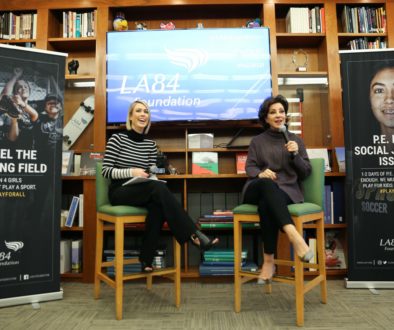SL Interview: What Does It Take to Be a Cheerleading Champion?
“Blood, Sweat & Cheers” is a new documentary film that explores the culture of competitive cheerleading. The movie follows Pop Warner cheerleaders from Burlington, Mass., as the girls in the junior midget division (ages 10 to 13) seek to win the national championship. The team has finished second for three consecutive years; this will be the final opportunity for the oldest members on the squad to taste victory.
In “Blood, Sweat & Cheers” (Amazon), cheerleading is shown to be part-sport, part-competition. At the elite level of Pop Warner, teams vie in regional competitions to qualify for nationals. Coaches spend hours breaking down tape so they can design and implement the most innovative and daring two-and-a-half-minute routines. The girls endure hours of grueling practices in order to master elements of gymnastics, intricate tumbling, syncopated athleticism and teamwork.
Cheerleading, the film shows, is not for the faint of heart, with the more dangerous maneuvers involving daredevil leaps, throws and flips. The film notes that a ninth-grader from a neighboring town died from injuries after falling while performing a stunt. Indeed, in a recent story in the Los Angeles Times, journalist Melissa Rohlin wrote that “cheerleading injuries resulting in emergency room visits have increased almost sixfold since 1980, to nearly 30,000 in 2008, the U.S. Consumer Product Safety Commission reported.”
SportsLetter recently spoke with Laura Molta, the president of Molta Media and the producer of “Blood, Sweat & Cheers.”
— David Davis
SportsLetter: Why did you and director Al Ward decide to make this film?
Laura Molta: Al has been covering the Pop Warner competitions in the Boston and New England region for the past 15-plus years. He’s been submersed in this culture and, seeing these kids, these parents, these fans so incredibly crazed about cheerleading, he thought it would make a good documentary. Al thought he might struggle interviewing the 13-year-old girls, so he asked me to come on board. We worked together as partners on the program.
SL: Do you or Al have a personal connection to cheerleading – did you cheerlead or are your own kids cheerleaders?
LM: Not at all. I’m single, not married. I never was a cheerleader, never was into cheerleading, never was friends with cheerleaders. Al has a two-year-old daughter and a seven-year-old son. But he got into it, seeing all these competitions, because his company shot them for Pop Warner.
SL: Were there other films that you thought of for this film?
LM: We looked at the film “Spellbound” [a documentary about the Scripps National Spelling Bee]. That definitely was inspirational. That seemed like a good formula, with a true beginning, middle and end. It looked at kids on their journey toward a success. It wasn’t really about whether they won or lost, but what the whole process to get there was about.
SL: What about Hollywood’s depiction of cheerleading, like in the film “Bring It On”?
LM: To be honest, I’ve never seen “Bring It On.” Again, I always had dismissed the sport of cheerleading. It wasn’t until I showed up for the very first practice at Burlington that I had that moment of “Oh, I get it.”
SL: What was the intended audience for the film: was it other cheerleaders or the festival circuit?
LM: We knew innately that it would have a cheerleading audience. That helped to inspire us. We’d love for people outside of the cheerleading community to embrace this film and enjoy the slice of life of a sub-culture that most people don’t know exists. We’ve been pleasantly surprised at how many men who came out to see the film with their spouse or their daughter or to support us as filmmakers have gotten into it and rooted for the girls to win. That feels like a success for us – that men who would not normally have gone out to see a film like this have enjoyed it and appreciated the sportsmanship.
SL: What attracted you to the Burlington Patriots cheerleading program?
LM: Burlington has won the most national titles in the country. We found it interesting that this little town in Massachusetts was racking up all the trophies because you’d expect a state with warmer weather – like Texas or Florida – to be the cheerleading champions. The town is also right in our backyard: our offices are about 15 minutes from Burlington. We knew that this would be affordable, convenient and easy to film. We could produce a film that wasn’t going to cost us an exorbitant amount in travel expenses. Of course, we didn’t know until the day of the final competition, when they announced the results, if the girls were going to win the nationals. We were sitting there like everybody else, biting our fingernails.
SL: What is the town of Burlington like?
LM: It’s about 12 to 15 miles north of Boston. Its biggest claim to fame is the mall, the Burlington Mall. It’s a really nice community of people who care about their kids. It doesn’t feel like a forced place. Many of the people who grew up there stayed to raise their own families. They surround themselves with family and really care about their community.
SL: How did Burlington develop a tradition of cheerleading excellence?
LM: They started winning competitions, and once they saw what it took, they said, “Let’s figure out exactly what the judges are looking for, let’s go after these skills and capitalize on that.” What they also did was encourage the parents in the community to get their girls into tumbling programs when they’re young, when they’re four and five years old, so they can learn how to do a standing tuck at an early age. The result is that cheerleading is much bigger than football in Burlington. Everybody who has a daughter has them in the cheerleading program. One parent was joking with me that, “My daughter does the $10,000 standing tuck,” because she had spent that much over the years in gymnastics and tumbling classes. These parents take it way beyond just cheering for you school.
SL: Is cheerleading a year-round activity and do the girls continue with cheer after Pop Warner?
LM: Their season parallels the football season, during the fall. Most of the girls participate in other cheer programs on the side. They take tumbling and stretching classes. They do whatever it takes to be a superb Pop Warner cheerleader. After junior midgets, these kids go off to high school. Some of them never perform again once they’re in high school, because the teams are just so competitive, especially in the town of Burlington. Usually, only five or six girls from the Pop Warner teams make it on the high school team.
SL: How would you define cheerleading: Is it a sport or a competition?
LM: After being a part of it, it’s definitely a sport. These girls are at two-hour practices after school for the entire season. The camaraderie among them: they’re pulling to help each other and support each other like teammates. They look at it like they are a team. They do not, at all, consider themselves to be performers. They consider themselves to be athletes. When you see the rigorous activity and the wear and tear on their bodies and the fact that they have to compete when they’re injured or sick, they’re treated like athletes and they’re expected to perform like athletes.
SL: Are there any sports you would compare cheerleading with?
LM: There’s gymnastics and tumbling, but I think it could be compared it to many team sports. Like football, where there’s choreography and a plan, where everybody has a role and where you need everybody to do their job perfectly in order to succeed.
Watching these girls compete and watching their camaraderie, it felt different than watching field hockey girls or volleyball girls. The cheerleaders are different, with a whole independent physicality. In cheerleading, you really stand out if you’re not capable. You can’t be there catching another girl if you’re not qualified. Everybody has their role, and you can’t do it without any one girl missing. With other sports, you can get through or survive if somebody’s missing.
SL: In the film, the girls seem less enthusiastic cheering on their school’s sports teams, as opposed to competing together as a cheer team. Did that surprise you?
LM: That struck me, too. Going into this, I truly believed that cheerleading was just about exciting the fans, getting into the school spirit, and being there to support whatever team was performing that day, usually football. But as one of the girls says in the film, they use the games as practice to hone their skills. When I would ask them about it, they’d go, “It’s fine. Of course we want to support the boys, but…” They kind of laughed off those games. That was not the real thing for them.
SL: How much time do they spend cheering on their school’s sports team?
LM: In football season, they appear at all the home games and many of the away games. During the other seasons, a lot of the girls play basketball, play softball, play other sports.
SL: These are middle-school girls: did you think that the routines they performed were dangerous?
LM: They were dangerous, there’s no question about it. There were parts of the routine where they’re tossing the girl six feet up into the air. At one of the practices, they dropped the girl. Having said that, they take safety very, very seriously. When we sent out the movie to be reviewed by people in the cheerleading world, one of the biggest concerns that the Pop Warner folks had was that we showed a couple of scenes of the girls performing without mats underneath them. They didn’t like seeing that because they are such sticklers for safety.
There’s no question it’s a dangerous sport. I think they do everything they can to practice safety first, but like anything there’s a lot of risk involved. I think some parents will have a hard time seeing these girls performing when they’re injured, but that happens all the time.
SL: In the film, you reference the death of a young cheerleader in a neighboring town. Did you witness any nasty falls, either with Burlington or with other teams?
LM: It was just the one fall at practice, where the girl fell about six feet to the mat. She was okay. But, no, fortunately we did not see any other serious injuries. At the last practice right before the national competition, one of the Burlington Patriots fell and landed right on her knee and then had to go out and perform. That was about the extent of it.
SL: Does the Burlington team practice with mats and with proper supervision?
LM: They do.
SL: Do they ever perform moves that they’re not capable of doing?
LM: The coaches are very tough on them. They push them to their maximum capability. I didn’t see any examples of the coaches pushing them beyond the ability they had. But when you play a competitive sport and have a lot of confidence in your ability, I think the expectation is that you’re going to push yourself. You may do something that’s out of your comfort zone. You may cause injury. But if you want to be a champion, then that’s what’s required.
SL: Do you think they need more regulations or safety precautions for cheerleading?
LM: I’m mixed on that. The practical side of me says yes, because safety should come before anything. But like other sports, the physicality is the name of the game. If they eliminate a lot of these stunts, then it won’t be as competitive a sport. I think there’s a safe way to do most sports, and maybe they should start the kids doing it when they’re a little older.
SL: How would you describe the parents’ involvement with the Burlington team: was it obsessive or was it healthy?
LM: I think it’s probably both. I think, at times, it does cross the line. You see the parents in the stands chanting along with the girls; they know the routines as well as the girls do. They’re carpooling and running these kids to every single practice and making sure that they show up at every event possible. When Kathleen [one of the girls on the Burlington team] was in the hospital for her emergency appendectomy, the parents went out and toilet-papered her house alongside their daughters. They’re all there at every juncture. They don’t miss a trip, they don’t miss a practice. We were at a Pop Warner competition a couple of weeks ago. It was about 40 degrees and pouring outside, and two hours before the competition, parents were standing in line to get the best seats. They’ll stop at nothing to watch their girls compete.
The cheer moms are probably not all that different from soccer moms. When you walk into their houses, you see the walls just covered with cheerleading paraphernalia. The parents were booking the trip to Disney [to the national competition in Florida] before the girls even have their first competition of the season. They take this as serious as having an Olympic athlete in the family.
SL: Would you compare what cheerleading coaches do to what coaches of traditional sports teams do?
LM: The coaches take this very, very seriously. They don’t look at it like, “Oh, these are just young kids that we want to have the experience of being part of a sport and learning to be good at something.” From when the kids are little, the coaches teach them that this is serious, that this is a commitment, and that they have to put their best foot forward at all times. Even when the girls had high scores [in competition], the coaches had critiques for them. What impressed me was that, even at a young age, the girls took the whole notion of becoming a good athlete seriously.
SL: What most surprised you in the making of the documentary?
LM: Truthfully, I was waiting for the cattiness. I was expecting to see these girls being nasty to one another and being clique-y. I think I was most surprised at how well they got along, how much they really supported each other. They were very mature. If anything, the cattiness was among the coaches, the parents, the moms.
SL: What’s the next step for “Blood, Sweat & Cheers,” in terms of marketing and distribution?
LM: Right now, we’re doing a grassroots effort to sell the limited edition DVD online and at cheerleader competitions. Ultimately, if we can get a large following, we will try to pitch it to a TV network. We’re starting to get excited about using it as an educational tool because it touches on building self-esteem and being good role models. It starts with the parents and the coaches: if they don’t set good examples for these kids, then the kids are not going to learn to be good sports or good people.
SL: What’s your next project?
LM: Right now we’re working a documentary about the flying car that’s being developed by a bunch of engineers from MIT. We’ve been working on this for about two and a half years, and we’re pitching it around to different networks right now.




